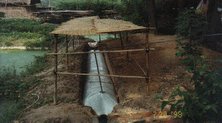Project Similipal..Eco Energy & Environment
We abuse land because we regard it as a commodity belonging to us. When we see land as a community to which we belong, we may begin to use it with love and respect.
Tuesday, April 14, 2009
Jatropha plantation
Thursday, February 01, 2007
Biodiesel
Jatropha for Biodiesel
This little known plant called "Jatropha Curcas" it all set to be used as a source of oil and has been/ is being used for making biodiesel and the production of electricity using biodiesel as a fuel.
 |
Running engines on vegetable oil is nothing new... did you know that Rudolf Diesel originally designed his engine to run on peanut oil? Maybe the US has not seen the light yet because they are mostly engaged in the growing of food crops and oils like soybean oil, rapeseed oil, sunflower oil, and peanut oil. All these oils are edible and thus fetch high prices. After all, why should US farmers grow a completely inedible plant!? Used cooking oil is great for the "do it yourself" enthusiast, but there is not enough supply of used cooking oil to supply a whole nation.
This is where Jatropha comes in... Jatropha has the following benefits when looked at from the fuel production angle:
- it costs almost nothing to grow
- it is drought resistant
- it can be grown almost anywhere - even in sandy, saline, or otherwise infertile soil
- it is easy to propogate (a cutting simply pushed into the ground will take root)
- it is not invasive, or spreading, or damaging like kudzu
- it is capable of stabilizing sand dunes, acting as a windbreak, and combatting desertification
- it naturally repels both animals and insects
- it lives for over 50 years producing seeds all the time
- it is frost hardy
- it does not exhaust the nutrients in the land
- it does not require expensive crop rotation
- it does not require fertilizers
- it grows quickly and establishes itself easily
- it has a high yield (Jatropha can yield about 1,000 barrels of oil per year per square mile - oil content of the seed is 55-60%)
- no displacement of food crops is necessary
- it is great for developing countries in terms of energy and jobs
- the biodiesel byproduct, glycerine, is profitable in itself
- the waste plant mass after oil extraction can be used as a fertilizer
- the plant itself recycles 100% of the CO2 emissions produced by burning the biodiesel
That's a whole lot of benefit with little or no disadvantages!
The European Union biofuels directive requires a minimum level of biofuels as a proportion of fuels sold in the European Union of 2% by 2005, 5.75% by 2010 and 20% by 2020. The main green fuels will be ethanol and biodiesel, and demand for biodiesel is expected to be up to 10.5 billion litres just in European countries by 2010.
Folks... this "biodiesel" thing is going to happen whether you like it or not! We know there are a lot of farmers, entrepreneurs, and investors reading this who can cash in on this biodiesl craze. They are already doing it big time in Europe so it's just a matter of time before it happens here. And by "it", I mean using Jatropha to make biodiesel. This industry will grow very quickly - start planting Jatropha TODAY and then start making biodiesel to generate your own electricity!
We will soon update the free biodiesel book and the electricity book with the following new information:
1) Some people ask about what kind of engine one needs to use biodiesel... basically, biodiesel will run in any diesel engine unmodified. Biodiesel is a solvent, so if you put it in an old tank or use it with a diesel engine that has been running regular diesel, it may clean and dissolve some "residues" and then the residues will clog your fuel filter. Changing the filter often when you first start using biodiesel usually fixes this problem.
2) The only other problem one might have is with rubber gaskets and hoses in vehicles made before 1992. The biodiesel may degrade these types of rubber and they may need replacing after a while. Newer engines have been modified to stand up to the newer blends of diesel fuel that have been in use since 1992 and these engines will work fine with biodiesel.
For more info check out www.biodieselmake.com
Friday, July 14, 2006
Benefits of using biogas
Biogas originates from bacteria in the process of bio-degradation of organic material under anaerobic (without air) conditions. In the absence of oxygen, anaerobic bacteria decompose organic matter and produce a gas mainly composed of methane (60%) and carbon dioxide called biogas. This gas can be compared to natural gas which is 99% methane.
Biogas collected can be used directly to power a cooking stove or as energy source for generators, boilers, burners, dryers or any equipment using propane, gas or diesel.
Biogas and the global carbon cycle.
Each year some 590-880 million tons of methane are released worldwide into the atmosphere through microbial activity. About 90% of the emitted methane derives from biogenic sources, i.e. from the decomposition of biomass. The remainder is of fossil origin (e.g. petrochemical processes). In the northern hemisphere, the present tropospheric methane concentration amounts to about 1.65 ppm(parts per million).
Unlike fossil fuel combustion, biogas production from biomass is considered CO2 neutral and therefore does not emit additional Greenhouse Gases (GHG) into the atmosphere.
However, if biogas is not recovered properly, it will contribute to a GHG effect 20 times worst than if methane is simply combusted. Therefore, there is a real incentive to transfer biogas combustion energy into heat and/or electricity.
Finally, biogas production from anaerobic digester presents the additional advantage of treating organic waste and reducing the environmental impact of these wastes. It contributes to a better image of the farming community while reducing odor, pathogens and weeds from the manure and producing an enhance fertilizer easily assimilated by plants.
The Benefits of Biogas :
A Polythene Biogas unit can yield a whole range of benefits for their users, the society and the environment in general, the chief benefits being;
1. Production of energy (heat, light, electricity).
2. Transformation of organic wastes into high quality fertilizer.
3. Improvement of hygienic conditions through reduction of pathogens, worm eggs and flies.
4. Reduction of workload, mainly for women, in firewood collection and cooking.
5. Environmental advantages through protection of forests, soil, water and air.
6. Global Environmental Benefits of Biogas Technology.
Saturday, April 29, 2006
Road to Dukura range.
Gas Connections
First exposure to a gas stove

This was the first time the beneficiary had seen a gas stove. All her life she has been cooking on firewood "chulhas". At first, she was worried as she thought that this is an electric stove and wanted to know where the wires would be fitted. After we demostrated the functioning of the stove and explained to her that it runs on gas created by cowdung, she was all smiles.
Although it will take some time before the full gas pressure forms for optimal usage..we were very happy that the process had begun.

WWF & Greenpower
Backyard of the beneficiary
Fixing the gas connection
Mass fishing !
Outlet of the digester
Biogas digester.
 Polythene biogas digester installed at Chandanchaturi village in Orissa. These biogas units are 10m long and 1m in diameter. The gas that is produced here(methane) is transported to the kitchen of the beneficiary, where it is stored in a polythene reservoir. This facilitates the use of gas as fuel anytime during the day or night.
Polythene biogas digester installed at Chandanchaturi village in Orissa. These biogas units are 10m long and 1m in diameter. The gas that is produced here(methane) is transported to the kitchen of the beneficiary, where it is stored in a polythene reservoir. This facilitates the use of gas as fuel anytime during the day or night. 
Friday, December 30, 2005
 This is a tribal kitchen supplied with biogas. The biogas is produced by the polythene bio gas digester installed outside their kitchen. The biogas digester is supplied with animal manure that the beneficiary collects from his livestock. Biogas is a clean, green fuel. It improves the health of people using it as it does not produce smoke or soot. It also reduces the greenhouse effect by digesting the manure in an anaerobic(without oxygen) condition. The by-product of the bio gas unit is very high quality fertilizer, which is used by the locals to suppliment their farming needs.
This is a tribal kitchen supplied with biogas. The biogas is produced by the polythene bio gas digester installed outside their kitchen. The biogas digester is supplied with animal manure that the beneficiary collects from his livestock. Biogas is a clean, green fuel. It improves the health of people using it as it does not produce smoke or soot. It also reduces the greenhouse effect by digesting the manure in an anaerobic(without oxygen) condition. The by-product of the bio gas unit is very high quality fertilizer, which is used by the locals to suppliment their farming needs. 
 A typical kitchen in a tribal household. Conventional kitchens use firewood for cooking which produce lot of smoke and soot. It directly affects the lungs and the eyes of people in the kitchen. Women and the children are the worst affected, as they spend most of the time in the vicinity of the kitchen. It also increases the greenhouse effect on the global level, and depletes the forest resources, as the firewood comes from the adjoining forest.
A typical kitchen in a tribal household. Conventional kitchens use firewood for cooking which produce lot of smoke and soot. It directly affects the lungs and the eyes of people in the kitchen. Women and the children are the worst affected, as they spend most of the time in the vicinity of the kitchen. It also increases the greenhouse effect on the global level, and depletes the forest resources, as the firewood comes from the adjoining forest. 
Wednesday, December 21, 2005
Cute little pups..
Tribal motif
Monday, December 19, 2005
Sun sets down ...
GPC and GPI
 Beneficieries with the benefactors banner next to the Biogas plant installed by GreenPower Canada and Greenpower India along with WWF,Orissa and MBR, Baripada.
Beneficieries with the benefactors banner next to the Biogas plant installed by GreenPower Canada and Greenpower India along with WWF,Orissa and MBR, Baripada. 




















